Czech anti-aircraft guns in the air defense of Nazi Germany
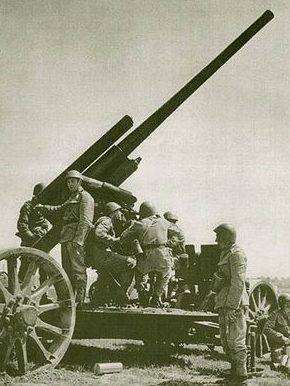
After the annexation of Czechoslovakia, more than 500 anti-aircraft guns of small and medium caliber were at the disposal of the German army. Subsequently weapons the factories of the Reich Protectorate of Bohemia and Moravia produced several thousand guns that were used by the armed forces of Nazi Germany and supplied to the satellite countries.
Small-caliber anti-aircraft artillery
The first rapid-fire anti-aircraft guns appeared in the Czechoslovak army shortly after its formation - in 1919. These were 20-mm Becker automatic guns (according to Czechoslovakian terminology - heavy machine guns), purchased in the amount of 47 units in Germany. Together with them, they bought 250 thousand shots.
The prototype of a 20 mm automatic gun chambered for 20x70 mm, designed by Reinhold Becker, appeared as early as 1914. The principle of operation of automation was based on the return of a free shutter and advanced ignition of the primer until the cartridge was fully chambered. Such a scheme of operation of automation made the weapon quite simple, but limited the power of the ammunition, and the initial velocity of the projectile was within 500 m / s. Food was supplied from a detachable magazine for 12 shots. With a length of 1 mm, the weight of a 370-mm machine was 20 kg, which, combined with a relatively small return, made it possible to install it on a light tripod machine.
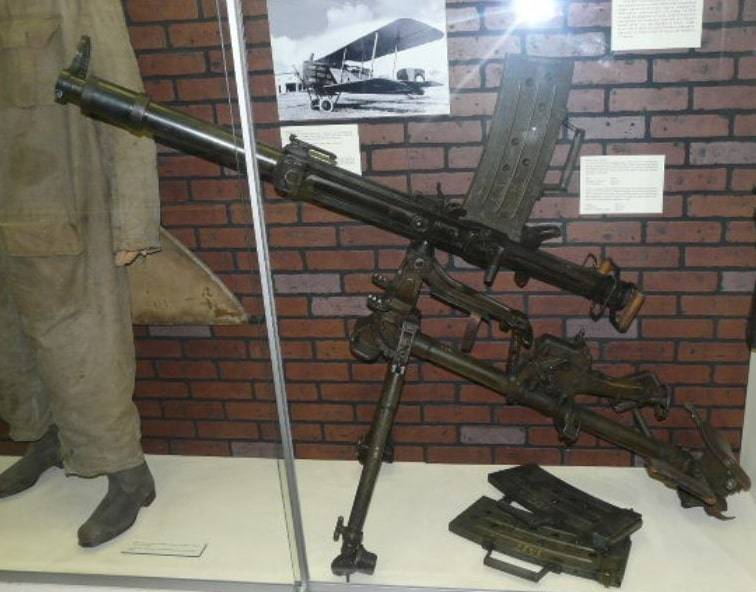
Becker's 20-mm cannon in the exposition of the Military History Museum in Prague
The Czechoslovak generals planned to use "20 mm machine guns" to protect crossings and bridges from low-altitude attacks by combat aircraft. However, the military quickly became disillusioned with the Becker guns, due to the low initial velocity of the projectile, the range and accuracy of fire made it possible to effectively fire at fast-moving air targets at a distance of no more than 600 m, which approximately corresponded to the capabilities of rifle-caliber anti-aircraft machine gun installations. Although by 1939 the Becker guns were hopelessly outdated, some of them remained in service. The Germans captured 29 of these anti-aircraft guns, later they were transferred to Slovakia.
Having gained experience in operating the first 20-mm machine guns, in the early 1930s, the Czechoslovak army began searching for a more advanced high-speed anti-aircraft artillery mount.
By that time, specialists from the Swiss company Oerlikon Contraves AG had brought the model known as 1S to mass production. Unlike the Becker gun, the new 20mm assault rifle was chambered for the more powerful 20x110mm cartridge. The muzzle velocity of a 117 g projectile was 830 m/s, which increased armor penetration and direct firing range. The weight of the gun without the machine is about 70 kg. The mass of the unit in transport position is 295 kg. Calculation of 7 people. Rate of fire - 450 rds / min. Elevation angles: -8° to +75°. In the brochures of the Oerlikon company, it was indicated that the reach in height was 3 km, in range - 4,4 km. The real capabilities of the anti-aircraft "Oerlikon" were about half as modest.
The first batch of 12 improved Oerlikons was purchased in 1934. After thorough field and military tests, the anti-aircraft gun was put into service under the designation 2 cm VKPL vz. 36 (2 cm heavy anti-aircraft machine gun mod. 36).
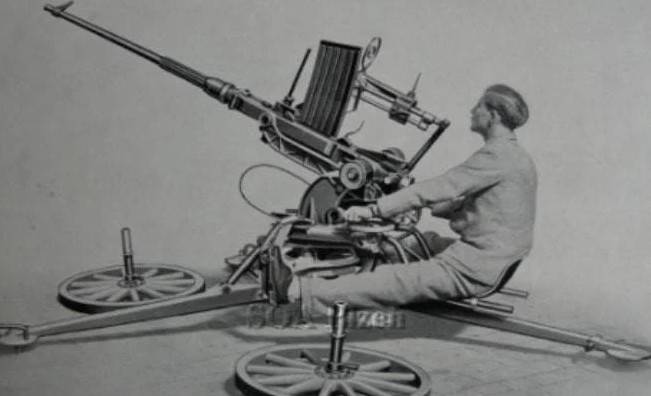
20 mm anti-aircraft gun 2 cm VKPL vz. 36 in firing position
In 1936, it was decided to purchase 424 2 cm VKPL vz. 36. However, these plans have not been fully realized. At the end of 1938, there were 285 20-mm Oerlikons in the combat units of the Czechoslovak army and in warehouses.
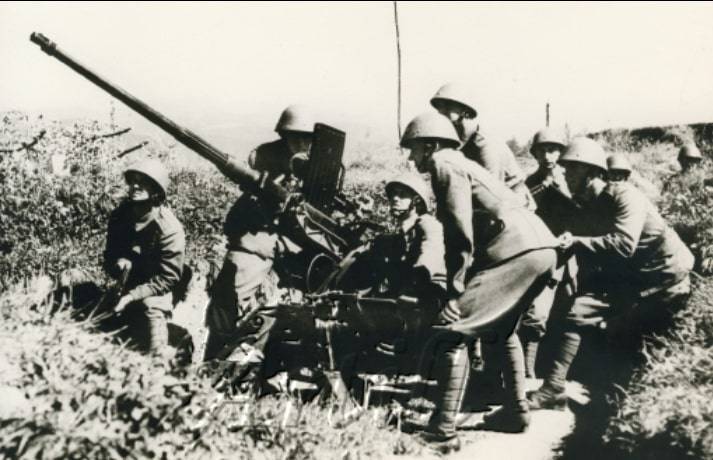
Calculation of anti-aircraft installation 2 cm VKPL vz. 36 in firing position
"Heavy machine guns" 2 cm VKPL vz. 36 equipped 16 air defense companies, which were mainly attached to "fast" (motorized) divisions. Anti-aircraft installations, as a rule, were transported in the back of two-ton Tatra T82 trucks.
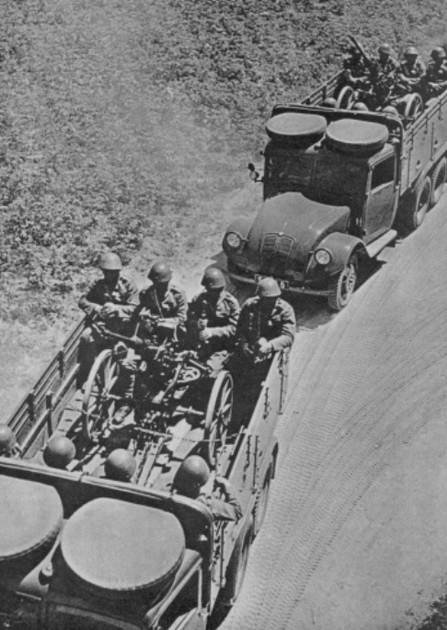
A significant drawback was the impossibility of firing from the back of a truck, for this the crew had to remove the anti-aircraft gun and deploy it on the ground. Subsequently, this problem was solved by installing a special platform in the body of a four-ton Tatra T85 car, which provides circular fire and the necessary elevation angles. It was the first ZSU in Czechoslovakia that could be used to escort transport convoys.
The armed forces of the Third Reich received 165 anti-aircraft guns 2 cm VKPL vz. 36, 62 more were transferred to the Slovak army. In VKPL vz. 36 used the same ammunition as the German Flak 28, and they served mainly in the air defense of airfields. Despite the availability of more modern 20 mm anti-aircraft guns, the Germans operated the 2 cm VKPL vz. 36 along with Flak 28 until the end of hostilities. The last Swiss-made 20 mm anti-aircraft guns were decommissioned in Czechoslovakia in the early 1950s.
During the occupation, Czech military factories not only produced German-style weapons, but also designed new ones according to German orders. So, for the Kriegsmarine, the design bureau of the Waffenwerke Brünn enterprise (as Zbrojovka Brno was called during the years of occupation) created a 30-mm twin anti-aircraft gun designed to arm submarines and small displacement ships.
Production of the 3,0 cm MK 303 (Br) twin naval anti-aircraft gun (also known as the 3,0 cm Flakzwilling MK 303) began in October 1944. The new anti-aircraft gun had a system for supplying ammunition from magazines for 10 shots, with a rate of fire from two barrels up to 900 rds / min. Compared to the German 30-mm anti-aircraft gun 3,0 cm Flak 103/38, the paired installation, created in the Czech Republic, had a much longer barrel, which made it possible to increase the muzzle velocity of the projectile to 900 m / s and bring the range of effective fire against an air target to 3 000 m.
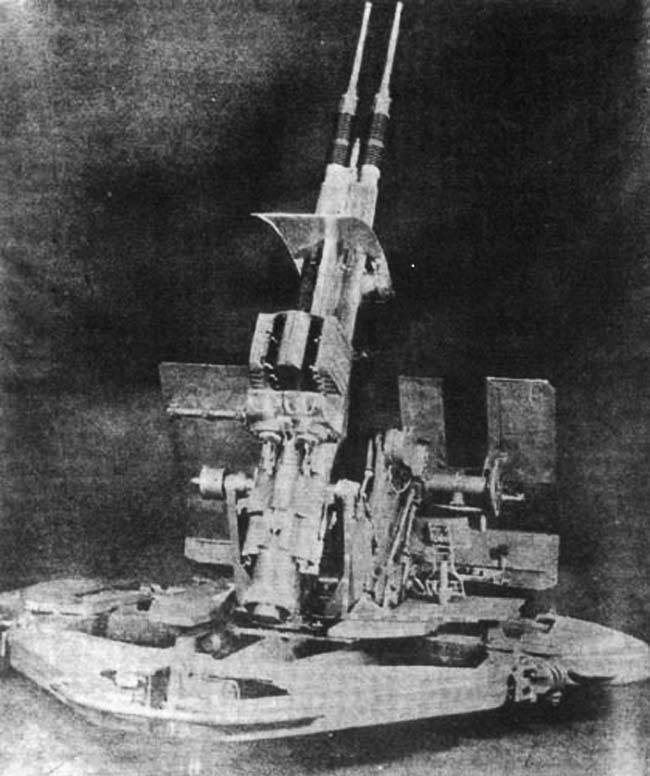
30 mm twin anti-aircraft gun 3,0 cm MK 303 (Br)
Although the twin 30-mm anti-aircraft guns were originally intended for installation on warships, most of them were used in stationary land positions. Before the surrender of Germany, more than 220 anti-aircraft installations 3,0 cm MK 303 (Br) were delivered.
Shortly after the adoption of the 47-mm anti-tank gun PUV vz. 36, Škoda created on its basis an anti-aircraft gun 4.7 cm kanon PL vz. 37.
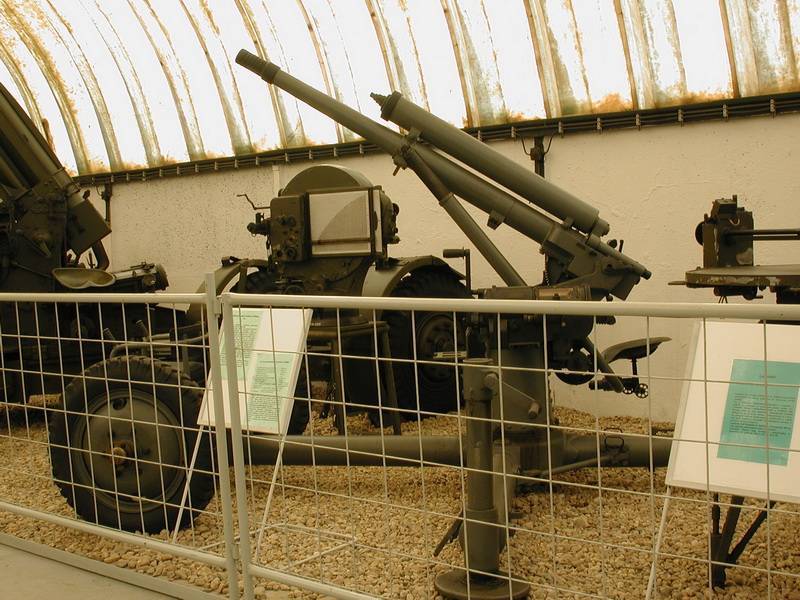
47-mm anti-aircraft gun 4.7 cm kanon PL vz. 37 in the museum exhibition
For firing from a cannon with a barrel length of 2 mm, a 040-mm fragmentation tracer projectile weighing 47 kg with an initial velocity of 1,6 m/s was used. The reach in height was 780 m. The rate of fire was 6 rds / min. To ensure all-round firing and better stability, the gun had four supports, the wheel axles served as two supports, and two more rested on jacks. The mass of the gun in combat position is about 000 ton.
Taking into account the fact that in the late 1930s the market for anti-aircraft guns was dominated by 37–40 mm machine guns, a gun with a semi-automatic shutter, which has a relatively low rate of fire for an anti-aircraft gun, did not interest the Czechoslovak military, who were leaning in favor of the 40 mm Bofors L60 machine gun. The only advantages of the Czech 47-mm semi-automatic anti-aircraft gun over the Bofors were lower cost and simplicity of design. A somewhat longer range of a direct shot and the mass of the projectile did not play a special role. The fragmentation-tracer 47-mm projectile was equipped with an impact fuse with a self-liquidator, but due to the low rate of fire of the gun, the tracer adjustment had almost no effect on the effectiveness of firing at fast-moving targets. In 1938, the Skoda company tested a 47-mm automatic anti-aircraft gun, but after the German occupation, work in this direction was curtailed.
Despite the obvious obsolescence of 47-mm semi-automatic anti-aircraft guns, they were ordered by Yugoslavia, after which the command of the Czechoslovak army decided to support the local manufacturer and also adopted the gun. The Germans, realizing the low efficiency of the 4.7 cm kanon PL vz. 37, used them as anti-amphibious guns, which could also conduct barrage anti-aircraft fire, and placed them in the fortifications of the "Atlantic Wall". In the Wehrmacht, these guns were designated as 4.7cm Flak 37(t).
Medium-caliber anti-aircraft guns
Czechoslovakia inherited 76,5 mm anti-aircraft guns 8 cm Luftfahrzeug Abwehr-Kanone M.5 / 8 MP from Austria-Hungary. This anti-aircraft gun was created on the basis of a 1905 model field gun. A notable feature of this artillery system was the barrel made of “steel-bronze” (“Thiele Bronze”), which was typical for some guns designed in the second half of the XNUMXth century.
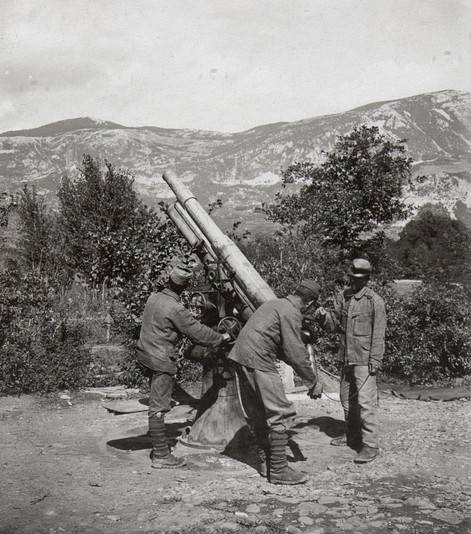
Such a barrel was made using a special technology: punches of a diameter slightly larger than the barrel itself were sequentially driven through a drilled channel. As a result, precipitation and compaction of the metal occurred, and its inner layers became much stronger. But due to its lower strength compared to steel, the bronze barrel did not allow the use of powder charges that were optimal for maximum firing range, however, bronze did not corrode and was less prone to tearing, and most importantly, such a barrel cost much less.
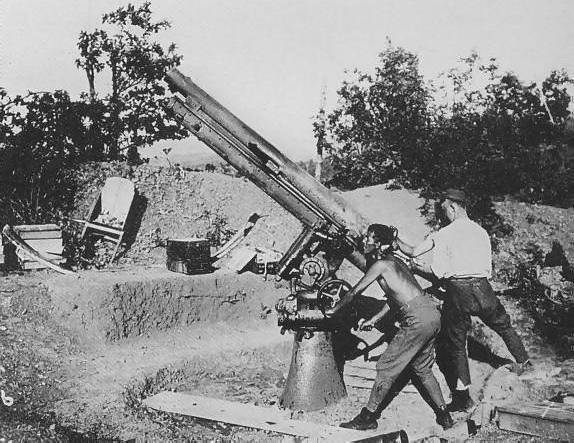
Anti-aircraft gun 8 cm Luftfahrzeug Abwehr-Kanone M.5/8 MP in firing position
In combat position, the anti-aircraft gun weighed 2 kg and had circular horizontal fire, and the vertical aiming angle ranged from -470 ° to + 10 °. The effective range of fire against air targets is up to 80 m. Rate of fire: 3–600 rds/min. For firing at air targets, a shrapnel projectile was used, weighing 7 kg and having an initial speed of 9 m / s. He was equipped with 6,68 bullets weighing 500 g and 316 g.
Initially, the gun did not have a wheeled carriage and was intended for use in stationary positions. In 1923, a four-wheeled cart was developed for an anti-aircraft gun, which made it possible to significantly reduce the time to change positions. By 1924, 76,5 anti-aircraft batteries were equipped with modernized 3-mm anti-aircraft guns, but the effectiveness of firing shrapnel shells with a low muzzle velocity remained low. Nevertheless, stationary and mobile anti-aircraft guns M.5 / 8 remained in service until 1939. Subsequently, these guns, like many other obsolete captured artillery systems, were used by the Germans in the fortifications of the Atlantic Wall.
From 1928 to 1933, 132 modernized Skoda 76.5 mm L/50 anti-aircraft guns were produced with a longer steel barrel and improved breech. Shooting was carried out with a fragmentation grenade weighing 6,5 kg, with an initial speed of 808 m / s. Rate of fire: 10-12 rds / min. Reach in height - 8 m. Elevation angles - from 300 to + 0 °. The mass of the gun in combat position is 85 kg.
A significant increase in firing efficiency was achieved due to the introduction of a control section with an optical rangefinder and POISO into the anti-aircraft battery. After the capture, the Wehrmacht used these anti-aircraft guns under the designation 7,65 cm Flak 33(t).
In the second half of the 1930s, Skoda specialists made an attempt to radically improve the characteristics of the 76,5-mm anti-aircraft guns. In 1937, the 8 cm Kanon PL vz. 37 with a 215 mm longer barrel and improved breech.
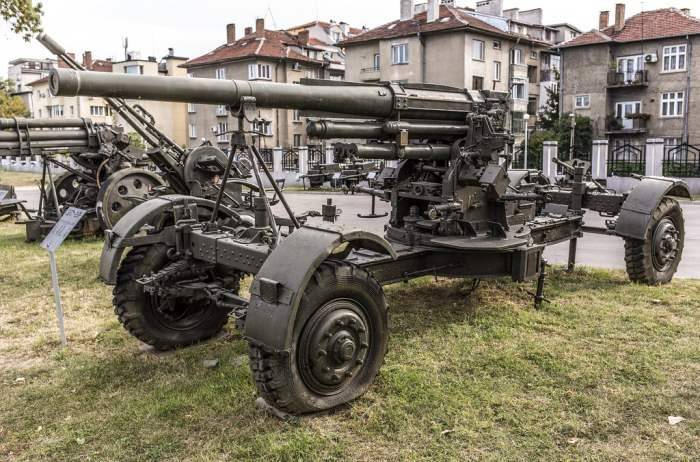
Anti-aircraft gun 8 cm Kanon PL vz. 37 in the museum exhibition
For that time, it was a completely modern anti-aircraft gun with a wedge gate and a detachable wheel drive. In combat position, it was hung on jacks on four sliding supports. The wheel drive was sprung. For firing, a fragmentation grenade was used, designed for 8 cm Kanon PL vz. 33. The rate of fire was 12-15 rds / min. The maximum range of fire against air targets is 11 m. The vertical aiming angles are from 400 to + 0 °. Between the autumn of 85 and March 1937, the troops received 1939 97 mm 76,5 cm Kanon PL vz. 8. They were subsequently divided between Germany and Slovakia. In Germany, these guns received the designation 37 cm Flak 7.65(t).
In 1937, the production of the 75 mm anti-aircraft gun 7.5 cm kanon PL vz. 37, which used a 75x656 mm R shot with a fragmentation grenade weighing 6,5 kg, leaving the barrel at a speed of 775 m/s. The vertical reach was 9 m. The rate of fire was 200-12 rounds / min. The mass of the gun in the combat position is 15 kg, in the stowed position - 2 kg.
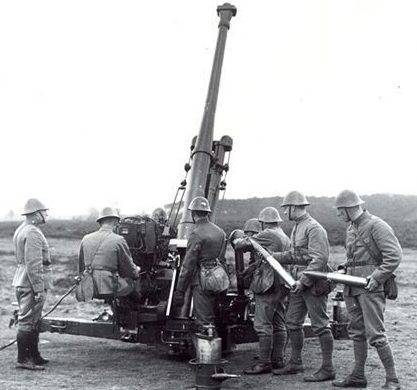
Anti-aircraft gun 7.5 cm kanon PL vz. 37 in firing position
Initially, the 75-mm anti-aircraft gun was intended for export, but subsequently a number of such guns served in the Czechoslovak air defense forces in parallel with the 8 cm Kanon PL vz. 37. Outwardly, these two artillery systems were very similar, they can be distinguished by the muzzle. The barrel of the 75-mm anti-aircraft gun ended with a muzzle brake of a characteristic shape.
75 mm guns 7.5 cm kanon PL vz. 37 were exported to Argentina, Lithuania, Romania and Yugoslavia. The Germans managed to capture 90 of these Czech anti-aircraft guns. Partially they were transferred to Italy and Finland. In Germany, they were referred to as 7,5 cm Flak M 37 (t). As of September 1944, the anti-aircraft units of the Luftwaffe had 12 such guns.
In 1922, a four-gun battery of 83,5-mm anti-aircraft guns was transferred for military trials, and after their successful completion, the towed artillery mount was put into service under the designation 8.35 cm PL kanon vz. 22. At that time, it was the best anti-aircraft artillery system in its class.
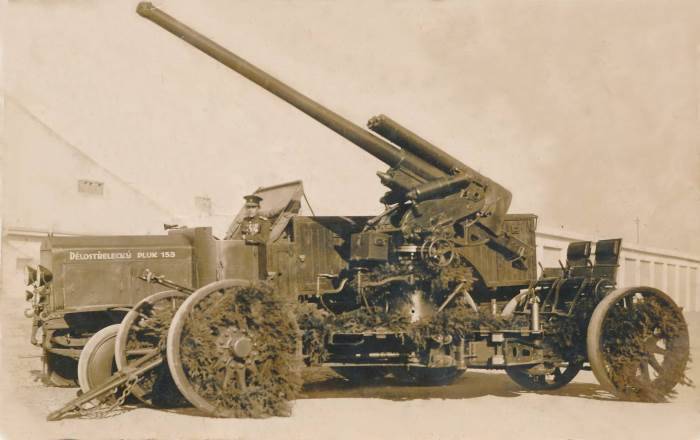
Anti-aircraft gun 8.35 cm PL kanon vz. Xnumx
The gun weighing 8 kg was developed by the designers of the Skoda company, based on the possibility of towing by a horse team with a maximum increase in caliber. For firing, a shot of 800x83,5 mm R was used with a 677-kg fragmentation grenade equipped with a remote fuse. The projectile left the barrel 10 m long with an initial velocity of 4,6 m/s. That made it possible to hit air targets at an altitude of up to 800 m. The rate of fire was up to 11 rds / min. Elevation angles: from 000 to +12°. Calculation of 0 people. The maximum travel speed is 85 km/h.
The order for 144 guns with spare barrels was fully completed in 1933, after which the 83,5-mm anti-aircraft guns began to be offered for export. However, due to the rather high price, the gun was not in great demand, Yugoslavia became the only foreign buyer.
Until September 1938, 83,5-mm anti-aircraft guns formed the basis of the Czechoslovak air defense system. In total, the Czechoslovak army had four anti-aircraft artillery regiments equipped with 8.35 cm PL kanon vz. 22.
In 1937, anti-aircraft guns 8.35 cm PL kanon vz. 22 have been upgraded. In connection with the increase in the speed of combat aircraft, a number of measures were taken to improve efficiency. Gun commanders had field telephones at their disposal, which transmitted information about the flight altitude, speed and course of the target. An improved optical rangefinder post was introduced into the anti-aircraft battery. Two or three batteries, deployed not far from each other, were given searchlight installations and sound direction finders.
After the occupation, the Wehrmacht received 119 83,5-mm anti-aircraft guns and almost 315 thousand shells, another 25 83,5-mm guns went to Slovakia. In Germany, the guns were marked 8.35 cm Flak 22(t). Czech sources claim that for the first time the Germans used captured anti-aircraft guns against French pillboxes on the Maginot Line.
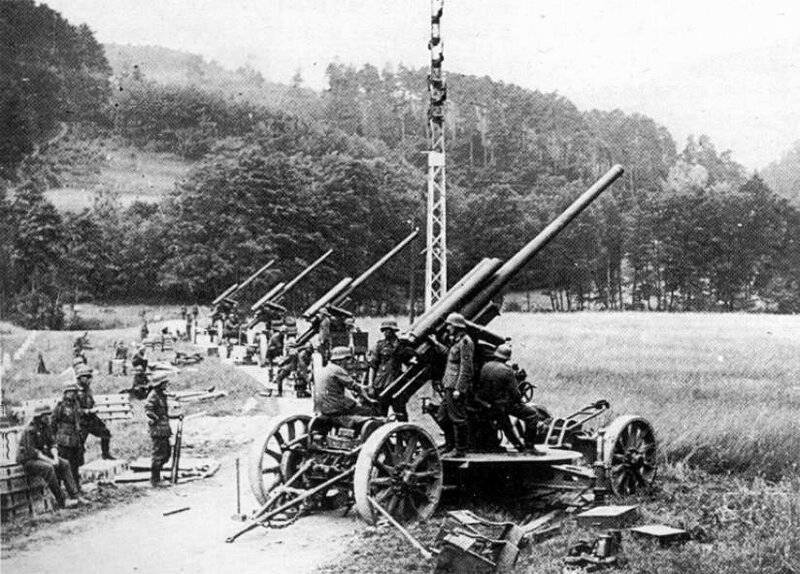
During World War II, 83,5 mm anti-aircraft guns were deployed in Poland, the Czech Republic and Austria. A dozen and a half hit the fortifications of the Atlantic Wall, where they could fire not only on aircraft, but also on ships. In 1944, Czech factories produced a number of 83,5-mm shots equipped with armor-piercing blanks, which made it possible to effectively deal with armored vehicles.
During the First World War at the Škoda factory for the Austrian fleet 90-mm guns were produced, used as an auxiliary caliber on cruisers. In 1919, eight 90-mm guns taken from warehouses were placed in stationary positions along the Danube. At the first stage, their main purpose was to counter the possible attacks of the Hungarian monitors, and the fight against the air enemy was considered as a secondary task. In 1920, a small-scale production of 9 cm PL kanon vz. 12/20 with improved sights and aiming drives, optimal for anti-aircraft fire. A fragmentation grenade with a remote fuse was introduced into the ammunition load.
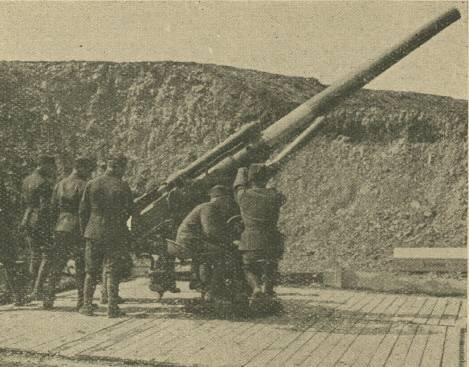
90 mm anti-aircraft gun 9 cm PL kanon vz. 12/20 in a stationary position
Gun weight 9 cm PL kanon vz. 12/20, placed permanently, was 6 kg. Barrel length - 500 mm. Elevation angles - from -4° to +050°. Projectile weight - 5 kg. Initial speed - 90 m / s. Reach in height - 10,2 m. Rate of fire - 770 rds / min. Calculation - 6 people.
Twelve newly manufactured anti-aircraft guns 9 cm PL kanon vz. 12/20 entered service with the 151st anti-aircraft artillery regiment of three batteries. Later, it included previously manufactured and overhauled 90-mm guns, as well as four stationary 8 cm Luftfahrzeugabwehr-Kanone M.5 / 8 MP
For the 1920s, 90 mm anti-aircraft guns were among the most powerful, but by 1938 they were outdated. The Germans in March 1939 got twelve 90-mm guns and more than 26 thousand shells. As guns of no particular combat value, they were removed from stationary positions and sent for storage. In 1943, due to an acute shortage of air defense systems, they were again put into service under the designation 9 cm Flak M 12 (t).
Продолжение следует ...
Information